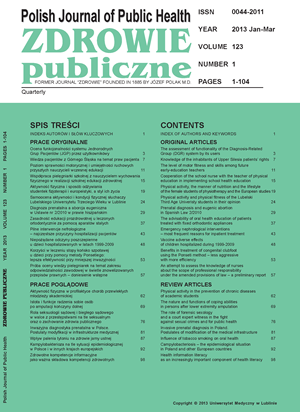Emergency nephrological interventions – most frequent reasons for inpatient treatment
DOI:
https://doi.org/10.12923/j.0044-2011/123-1/a.09Keywords:
emergency nephrological conditions, nephrological interventions, admissions analysisAbstract
Introduction. Kidney diseases represent a significant medical and social issue. Modern medicine has made immense progress in the process of diagnostics and treatment of the said diseases. However, the effective prophylactics and possibly the promptest medical assistance in cases demanding emergency nephrological intervention remain the key questions here.
Aim. The purpose of this paper was to assess the reasons for emergency admissions of patients with kidney diseases to hospital and determine the scale of emergency interventions at the nephrological department.
Material and methods. The research was carried out based on the analysis of a retrospective group of 3334 patients of Independent Public University Hospital No 1 in Zabrze, who checked in the nephrology emergency room throughout the years 2005-2010. The research included adults with nephrological ailments, both dialyzed and non-invasively treated. The admission indications were presented in 14 categories.
Results. Approximately 50% of patients admitted to the Nephrological Department were of both sexes, in the 18-93 age group (average age – 56). The most frquent reason for emergency interventions was the condition qualifying for renal replacement therapy (18.3%). Patients with systemic ailments accompanying renal dise-ases constituted 14.2%, 12.8% patients had hemodialysis catheter dysfunction, 11.8% – patients with dialysis related acute peritonitis; 11.1% – were hemodialyzed patients with pathological symptoms of other systems; 14.7% – were hemodialized patients with similar ailments. Patients admitted with acute renal failure accounted for 4.3%, while 2.8% of all the patients admitted to the emergency room had urinary tract infections. Other rare cases in the patients admitted represent ca. 10%.
Conclusions. 1. The number of emergency nephrological interventions was ca. 50% compared to the total number of patients and no declining tendency has been observed.
2. The number of male patients hospitalized for lifesaving reasons exceeded the number of female patients. The most frequent causes for hospitalization were sepsis symptoms in male patients and urinary tract infections in female patients.
3. The highest rate of causes demanding emergency nephrological assistance includes qualifications for renal replacement therapy.
References
1. Penar J, Klinger M. Zapalenie otrzewnej – kiedy leczenie chirurgiczne? Nefrol Dial Pol. 2010;14(4):218-9.
2. Szczeklik A. Choroby wewnętrzne. Stan wiedzy na rok 2011. Kraków: Med Prakt; 2011. p. 1329-465.
3. Więcek A, Kokot F. Postępy w nefrologii i nadciśnieniu tętniczym. Kraków: Med Prakt; 2009. p. 1-156.
4. Rutkowski B. Dializoterapia. Nefrologia postępy w 2008 r. Polskie Towarzystwo Wakcynologii. Med Prakt. 2009;3:81-3.
5. Gętek M, Nowakowska-Zajdel E, Czech N, et al. Quality of life patients on dialysis and after renal transplantation. AAMS. 2010;64(5-6):23-30.
6. Małyszko J, Małyszko JS, Bochórzewska-Gajewska H. Problemy nefro¬logiczne spotykane w oddziale kardiologicznym. Białystok: Wyd. Uni¬wersytet Medyczny w Białymstoku; 2009. p.153.
7. Banachowicz W. Analiza przypadków ostrej niewydolności nerek. Now Lek. 1999;68(5):573.
8. Książek A, Rutkowski B. Nefrologia. Lublin: Wyd. Czelej; 2004. p.173.
9. Kokot F. Ostra niewydolność nerek w przebiegu sepsy – aspekty patogenetyczne i lecznicze. Med Prakt. 2005;03:213-6.
10. Myśliwiec M. Choroby nerek. Warszawa: Wyd. Lek. PZWL; 2008. p.305.
11. Daugirdas JT, Blake PG, Ing TS. Podręcznik dializoterapii. Lublin: Wyd. Czelej; 2008. p.63.
12. Rutkowski B. Leczenie nerkozastępcze w praktyce pielęgniarskiej. Gdańsk: Wyd. VIA Medica; 2008. p. 34-446.
13. Dąbska-Ślizień A, Śledziński Z, Rutkowski B. Jak żyć z przeszczepioną nerką. Lublin: Wyd. Czelej; 2006. p.23-109.
14. Leowski J. Polityka zdrowotna, a zdrowie publiczne. Warszawa: Wyd. CeDeWu; 2010. p.11-7.
15. Rutkowski B, Czekalski S. Rozpoznanie i leczenie chorób nerek – wytyczne, zalecenia i standardy postępowania. Poznań: Wyd. Termedia Wyd. Med.; 2008. p.194-211, 228-35, 319-41.
16. Gętek M, Czech N, Białek-Dratwa A, et al. Jakość życia chorych poddawanych przewlekle leczeniu nerkozastępczemu – przegląd piśmiennictwa. Hygeia Public Health. 2012;47(2):151-6.


